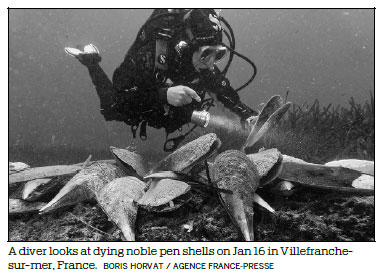Tiny killer threatens giant clam, an aquatic emblem of the Med
VILLEFRANCHE-SUR-MER, France - With wing-shaped shells lined with iridescent mother-of-pearl and producing the fibers of rare and delicate sea silk, the noble pen shell clam is one of the most emblematic species in the Mediterranean and a bellwether for marine environmental health.
But the giant mollusk, the world's second biggest, is under mortal threat from a parasite that has ravaged populations since it was identified along Spanish coasts in 2016.
Scientists fear that climate change and warming waters will intensify the devastation, which they now class as an emergency.
The noble pen shells, or Pinna nobilis, can live for up to 45 years and grow to about 1.2 meters.
They are only found in the Mediterranean Sea, standing proudly upright like ships' sails, their tips anchored in sandy sea grass meadows by sinewy fibers.
On the tranquil surface of the water at Villefranche-sur-Mer, near Nice in southern France, there is little evidence of the carnage below.
But dive down and the seafloor is a graveyard of noble pen shells.
Death has shriveled the flesh of the mollusks and dulled the mother-of-pearl to a rusted brown inside the shells, in an area abandoned by the usual myriad of tiny cohabitors - little crabs, shrimps and orange sea fans.
"We cannot find a living one," said diver Olivier Jude, emerging, camera in hand, from the bay after an unsuccessful attempt to photograph the Pinna nobilis for his Phoctopus website.
The French Riviera is the latest site of the die-off, caused by the relentless assault of a new parasite that weakens the clam, quickly starving it to death.
Weakened, starved
The pathogen has almost eradicated the noble pen shell population off the Spanish coast, where it is now listed as critically endangered, and has spread to other coastal areas.
It is now attacking the clams from France to Turkey.
"The situation is deeply alarming," Maria del Mar Otero, a marine expert at the International Union for Conservation of Nature's Center for Mediterranean Cooperation, adding that the species was "on the verge of disappearing" in Spain.
Fields of the giant mollusks clustered on the coastlines of the Mediterranean have been known to coastal communities for centuries.
An IUCN map of the affected region, periodically updated since the beginning of the crisis, is studded with a growing number of red dots corresponding to mortality rates of above 85 percent.
The southern Spanish coast is hemmed almost entirely in crimson, while scarlet spots are also clustered around the French island of Corsica, in Italy, Turkey, Cyprus and Greece.
French marine biologist Nardo Vicente, of the Paul Ricard Institute of Oceanography, has monitored a field of noble pen shells off the coast of Corsica since the early nineties. "In 2017, the field was in perfect health. This year, everything was dead, absolutely a hundred percent!"
Agence France-presse

(China Daily 01/26/2019 page7)














